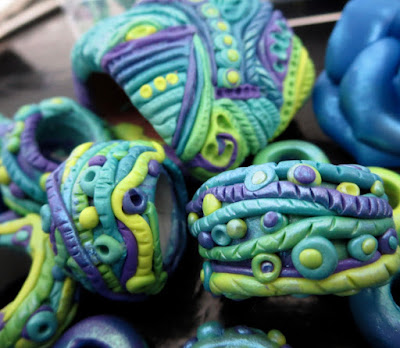Colour Mixing 101
Being able to mix colours in polymer clay like you can with paint is a wonderful thing. It is why I love working with polymer clay, painting in three dimensions! These beads were made by creating a colour been using a technique called the "Skinner Blend." It was created by someone named Judith Skinner. You can make it with a roller or a pasta/clay machine. Click here to see a tutorial on how to create a skinner blend, by a great new channel I like called "Jessama Tutorials."
Some folks like to mix colours of clay that are premixed by the company that makes the clay. It is a good way to start. But if you love colour mixing like I do, you often like to mix your own colours first and then put them into a skinner blend mix. These beads were created a little while ago so I can't remember for sure what I did. I think I used ready Mix colours, Premo (pretty much the only clay I use) Turquoise, Wasabi and Purple. Then they blend into some really great variations.
It is helpful to know the basics of colour mixing to achieve a palette you would like. Click here for some Colour Wheel Images.
In Paint it is easy to mix combinations of paint do see what colours create when combined. With Polymer Clay you can practice using little amounts if you want to by smooshing little portions of clay.
It helps to know the basics of colour mixing.
Primary Colours are: RED, YELLOW and BLUE. They are called Primary because we can't create them, hence the name "primary."
*Colour Note: of all colour results will vary depending on the primaries you use to begin with. For example mixing Cobalt Blue and Alizarin Crimson make a different purple than Cadmium Red mixed with Cobalt Blue.
Secondary Colours meaning we need to take two Primaries to make a Secondary colour: BLUE + RED = VIOLET/PURPLE
RED + YELLOW= ORANGE
BLUE + YELLOW= GREEN
Tertiary Colours are when we combine three colours to achieve yet another colour!
Analogous colour palette is what I ended up using for these beads. Analogous means using colours that are beside each other on the colour wheel.
Complimentary Colours are when you use colours that are opposite each other on the Colour Wheel. Because they are opposite, it is a great way to make a colour "pop!" Experiment, have fun and create what you love!
 |
| Here are some of these fun textured, large hole beads and one very large focal bead! Take a look.... |
 |
| Since I love designing beads, I also made an array of smaller tube beads. Save all your bits of clay so you can make elements like dots and strips and whatever you can think of. |
 |
| To highlight areas and add shimmer, I did dust on some mica powders. Use your own preference. I just like shimmery mica powders. |
 |
| Here they are. All cooled and ready to be turned into wearable art! |













No comments:
Post a Comment